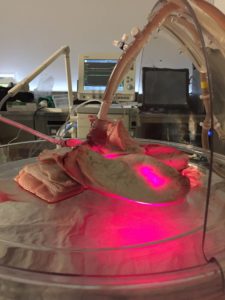Sao Paulo, Mar 23 (EFE).- Researchers at the University of Sao Paulo have discovered a way to sterilize organs to be used as transplants, thanks to a novel use of light to eliminate any virus or bacteria the donor might carry.
According to specialists, biophoton therapy, as it is known, will undoubtedly increase the number of organs available and reduce after-surgery complications.
“At present the sterilization of organs for transplants does not exist. What is done is to simply remove the blood, but the microorganisms remain alive. Either the organ is discarded or, if there is no other way to avoid death, it is implanted though still contaminated,” the coordinator of the group of scientists, Vanderlei Bagnato, told EFE.
The research got underway in 2015 in coordination with the University of Toronto, which developed the most extensive program of lung transplants in the world. The Canadians took charge of the clinical part of the project, while the Brazilians developed the technology.

Some $1 million were invested and the Brazilian part, roughly 10 percent of the project, went to the Sao Paulo Research Foundation.
The procedure consists, firstly, of removing the organ’s blood and substituting it, through an external tube, with a liquid that keeps it alive.
This liquid is exposed to ultraviolent rays, which destroy the cellular membranes of the microorganisms and their DNA.
“The ultraviolet rays are applied outside the organ so as not to kill its cells, but rather eliminate the viruses and bacteria captured by the liquid,” Bagnato said.
Placed in the liquid as a complement, on the other hand, are substances sensitive to visible and infrared light, which are capable of selecting viruses and bacteria.
Later, these light frequencies are applied to the organ and stimulate the substances to oxidize the microorganisms and attack such viruses as hepatitis and AIDS.
According to the scientist, the liquid is used more than once because it is still very expensive, with a price of $1,500 per liter (0.26 gal.).
The original experiments were done on pig lungs, then on humans without transplants, and finally they were done on patients.
For the head of the project in Canada, Marcelo Cypel, the results were outstanding.
“We have done 10 tests with patients, in two of which the presence of the virus was eliminated and in eight it was significantly reduced,” Cypel said, while Bagnato added that the bacteria have been “completely extinguished.”
In Canada the technology has already been patented and there are companies interested in manufacturing the equipment it requires. In Brazil, the goal is to test the program on kidneys and livers, the two organs most often transplanted in the South American country.
Scientists believe that in the future the use of organs can be improved, costs and waiting time reduced, and other transplants, like those of the heart and pancreas, expanded.
“Now there are transplants of everything – of the uterus, of the face. But it’s very expensive. A lung transplant, for example, costs around $160,000. In Brazil, about 10 of those are done a year, but how many people need it?” Bagnato asked.
In 2018, 20,000 transplants were needed in Brazil of vital organs like kidneys, hearts, livers and lungs, but only 8,500 were performed. The waiting list for surgery is more than 30,000 people, according to the Brazilian Transplant Association.
